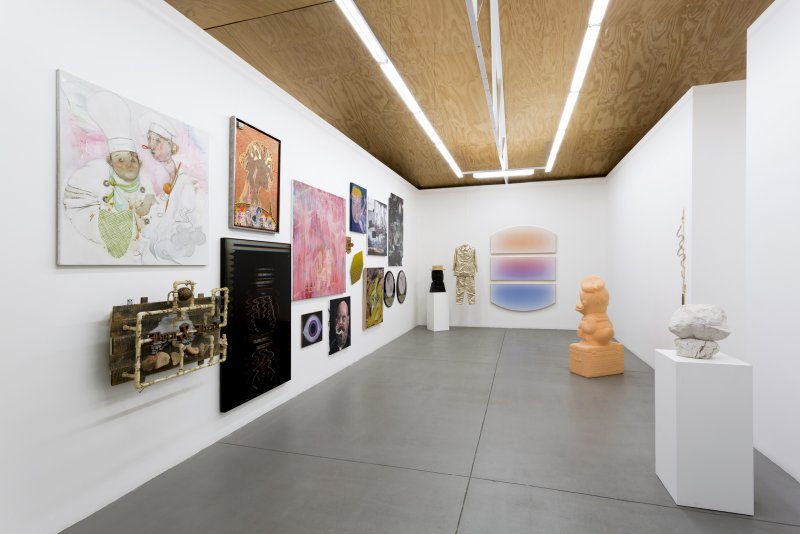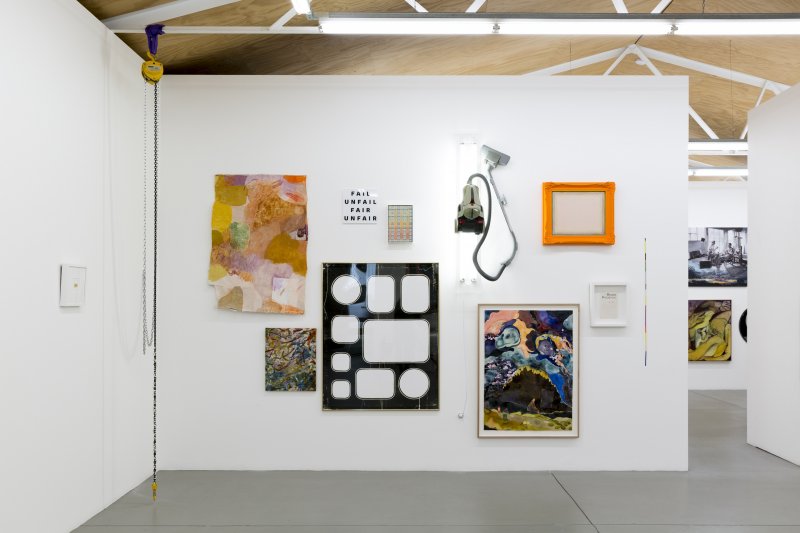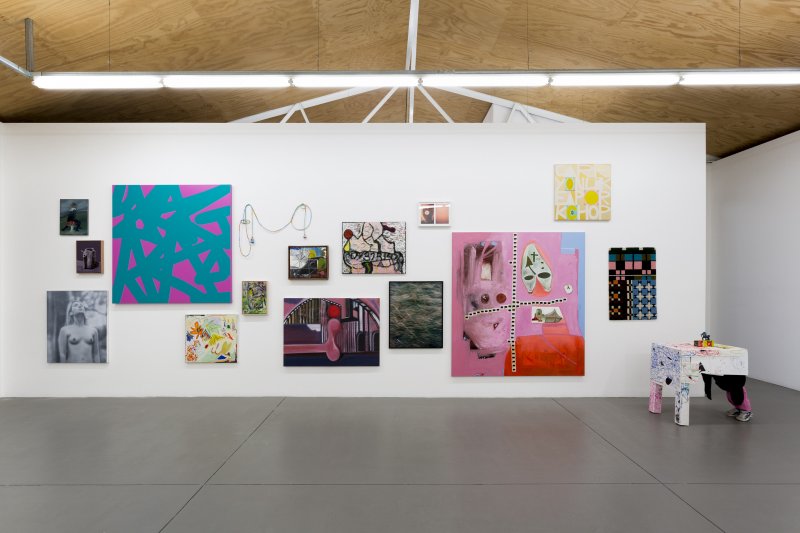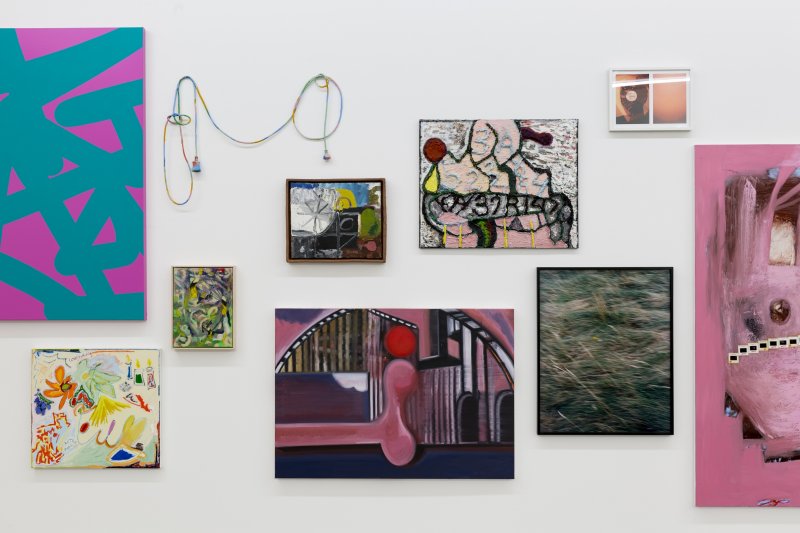The Mirror
EditorialAboutA+a Study CentreA+a ArchiveShopClose Menu

...Throughout the period of Melbourne and Sydney's lockdowns STATION Gallery hosted a range of online exhibitions and a largescale anniversary exhibition. STATION Gallery's Director, Samantha Barrow discusses the trials and tribulations of this period, how the gallery maintained contact with their community and the opportunities that have arisen from new ways of working.
The STATION team has dispersed and are now all working from home, across Melbourne, Sydney and Brisbane. On occasion staff members have needed to attend the gallery to provide access for courier pick up and deliveries. When restrictions have permitted exhibitions have been de-installed, installed and documented with as few people as possible present. This has been very important to allowing us to keep the program moving and to generate the essential material required to present exhibitions online. In a few instances such as: Police Camp: Passive Recreation Area by Clare Milledge in April/May 2020, the exhibition was completely digitally rendered, as neither the artist or STATION team were able to access the gallery during the very early lockdowns. It is an exhibition that we are extremely proud of given the circumstances at that time and the wonderful reception that it received from our audiences.
As a team, we naturally work in a highly collaborative manner. Moving to working from home, we used Zoom multiple times a day to catch-up, along with many phone conversations. Since the first lockdowns Zoom became a highly useful tool, to facilitate conversations between Sydney and Melbourne team members, undertake studio visits with artists and hold client meetings. The potential for emotional distress caused by the uncertainly of these times for both our staff and artists is a serious concern. As much as possible we have been trying to keep in contact, through phone calls and emails that are aimed at just catching up or Zoom events on a Saturday afternoon where we all get to see each other’s smiling faces online.


In a challenging year, our 10 year anniversary exhibition has been the absolute highlight. It brought together works by 74 artists, all of whom at some stage have shown with STATION. Most disappointingly our big celebratory opening event never eventuated, but we held a series of well attended and engaging artists talks, every Saturday for the duration of the exhibition. Looking back now in the midst of our lockdowns, it is hard to believe it even happened. It was a huge amount of work to co-ordinate with so many artists and install all the artworks, but the effort was well worth the joy of bringing the STATION community together. We are still holding out hope and looking forward to an opportunity for us to actually celebrate.
A need for sustained innovation and flexibility has been COVID’s overarching influence on STATION. Rolling COVID lockdowns created a myriad of scheduling and logistical issues. The first shift was to creating engaging online content to complement our exhibition program, overnight we became video producers and webinar moderators. In 2020, during the height of Melbourne’s lockdown we rolled out a series of Zoom based artists talks, to coincide with each exhibition. We partnered with OH! Media to install a street level exhibition of artists' works on bus shelters and train stations across the whole of metropolitan Melbourne. We produced short videos that served as introductions to our artists' practices and archival records of exhibitions never physically visited, but none-the-less central and important to their oeuvre. This experience served us well in 2021 as we leaned in to the many weeks and months that we continued to be locked down.
In February 2021 we remotely presented a major exhibition by Daniel Boyd at the Auckland Art Fair, hiring a local team on the ground to staff the booth and we had a gallery team here readily available for client conversations. It was challenging, especially as we were simultaneously opening an exhibition in Melbourne but we were determined to follow through with our commitment to the artist and the fair organisers, even when faced with international travel restrictions, local lockdowns in Auckland and exorbitant freight costs.

The success of Auckland Art Fair and this remotely managed model has made us confident in continuing to apply for international art fairs in 2021 and beyond. Whilst COVID has restrained our physical capacity to travel, it has not dampened our ambitions for taking our artists overseas, which is one of STATION’s most enduring priorities.
Undoubtedly the whole industry has become more acutely aware of the importance of their digital presence and reach. Everyone acknowledges that whilst there is no true possibility or even desire for replacing the experience of an artwork or exhibition in the real, a form of sustenance can come from online engagement.
The impulse to de-center the art world has been an ongoing project of the past several decades, pioneered by key curators and critics such as the late Okwui Enwezor. The shift of all programming across the many arms of the industry from Biennales, Art Fairs, commercial gallery and not-for-profit spaces, to online platforms has removed the necessity of physical travel to engage with the public. The platform of art has become unmoored and is able to shift at light speed from one location to the other. Artists from multiple locations can participate in a panel discussion via Zoom, to be shared live or watched later at the viewers discretion. The possibility of open dialogs seems infinite, albeit confined to the frame of the screen.
Using forms of digital engagement ranging from Zoom artists talks, video presentations, online exhibitions, social media and dedicated platforms such as Artsy, present great opportunities to elevate the exposure of our artists to international audiences now and into the future. Associated with this shift to online presentations is an increasing democratisation of the art collecting process. Online art fairs and viewing rooms have led to pricing transparency, allowing collectors the ability to anonymously research artists within budget brackets, efficiently and without fear of embarrassment over having to ask “how much is it?”. This has encouraged new buyers to engage with galleries, many new collectors making their first major purchases during this time.

Around the world we have seen established galleries taking their exhibitions to the locations were collectors have congregated away from major city centres. In the US this is the Hamptons outside New York and Palm Beach, Florida. In Europe, major auction houses and galleries have established operations in Monte Carlo. Seizing on a similar concept in January 2021, STATION along with six other galleries participated in the inaugural three day long Quarantine Art Fair on the clifftop of Portsea’s Point Nepean National Park.
Each of our artists have experienced the pandemic in their own highly personal and specific way, having to reckon with the complete disruption to their way of life. Some of our artists who are based overseas have faced the most significant challenges such as family deaths, having COVID themselves and intense fear for the wellbeing of themselves and their families. For artists with young children, work commitments, studios that are deemed inaccessible and/or lack of space, making time to continue their practices has been extremely hard. This being said, just the sheer strain of the pandemic could be sufficient to cause extreme emotional distress. Some artists have found resilience by scaling back their practice and works to that which is achievable within the given constraints, such as Jon Cattapan’s wonderful kitchen table top drawings, Sarah Contos’ 2020 paintings from the exhibition My Friend, Lavender or Tom Polo’s 2021 series of works of paper included in stains, stages, strangers that were intended for the cancelled SPRING1883 art fair.
The stop/start nature to programming and the endless uncertainly over lockdowns eventually led to a pervasive sense of fatigue. It is difficult to maintain motivation to work towards a project or exhibition that is either being perpetually delayed or mostly likely to be installed but not open to the public. We tried to maintain some level of certainty to our schedule, as a means to create stability and confidence in the future for our artists. It meant many compromises, sometimes having exhibitions open for just one week, sometimes not at all. In Sydney just before their lockdown, Natasha Johns-Messenger and Leslie Eastman installed an ambitious site specific installation work, so complex, but visually minimal that it evades the possibility of communication through online documentation. In this instance we were committed to leaving the exhibition installed until a time came when it could be viewed in person. To solve the issue of continuing the program, we looked for alternative spaces in our building to install other exhibitions concurrently. Allowing the other artists in the Sydney program to have confidence towards the dates of their exhibitions.
The shift to online-only-exhibitions has disproportionately effected collector activity for artists. Bodies of work exhibited online for artists who are already known and are working within a style and a set of materials they are known for, have been extremely well received. Especially as clients are still actively looking to add to their collections. Introducing a newer artist or a body of work that is substantially different to previous works from a known artist, has been more difficult. Engagement and interest has still been high, but buyers are less likely to commit without the embodied experience of standing in front of the work.
Prevailing circumstances and the disruption to the global art fair calendar has also led to an increased interest in commercial gallery exhibition programs. As collectors spend more time dwelling in a single location, they are unable to travel and seek out new experiences. In lieu of this, following a gallery and engaging with an ever changing program, can be of great solace. It is comforting to know that artists who are often at the forefront of tackling humanities’ greatest challenges are still making new work. That the tumultuous times we are in are being addressed through this work, directly or indirectly and that there continues to be the flow of cultural production so central to our existence and experience of the world.
Author/s: Samantha Barrow
Samantha Barrow. 2022. “STATION Gallery.” Art and Australia 57, no.2 https://artandaustralia.com/57_2/p48/
Art + Australia Editor-in-Chief: Su Baker Contact: info@artandaustralia.com Receive news from Art + Australia Art + Australia was established in 1963 by Sam Ure-Smith and in 2015 was donated to the Victorian College of the Arts at the University of Melbourne by then publisher and editor Eleonora Triguboff as a gift of the ARTAND Foundation. Art + Australia acknowledges the generous support of the Dr Harold Schenberg Bequest and the Centre of Visual Art, University of Melbourne. @Copyright 2022 Victorian College of the Arts The views expressed in Art + Australia are those of the contributing authors and not necessarily those of the editors or publisher. Art + Australia respects your privacy. Read our Privacy Statement. Art + Australia acknowledges that we live and work on the unceded lands of the people of the Kulin nations who have been and remain traditional owners of this land for tens of thousands of years, and acknowledge and pay our respects to their Elders past, present, and emerging. Art + Australia ISSN 1837-2422
Publisher: Victorian College of the Arts
University of Melbourne
Editor at Large: Edward Colless
Managing Editor: Jeremy Eaton
Art + Australia Study Centre Editor: Suzie Fraser
Digital Archive Researcher: Chloe Ho
Business adviser: Debra Allanson
Design Editors: Karen Ann Donnachie and Andy Simionato (Design adviser. John Warwicker)
University of Melbourne ALL RIGHTS RESERVED
